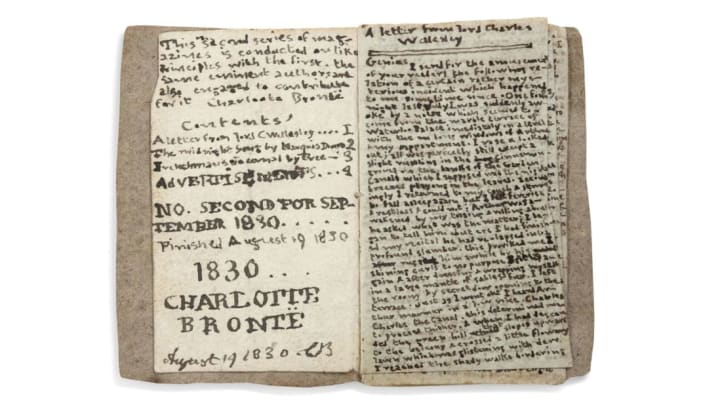Soon after his father gave him 12 toy soldiers as a gift, Branwell Brontë and the three Brontë sisters—Charlotte, Emily, and Anne—established an imaginary, miniature land called the Glass Town Federation where the soldiers could reign. To supplement their game, 14-year-old Charlotte Brontë wrote a series of six books beginning in 1830 called “The Young Men’s Magazine,” which she made tiny enough for the soldiers to “read.”
Four of the books are kept at the family’s former home, now the Brontë Parsonage Museum, in Haworth, Yorkshire. A fifth volume has been lost since the 1930s. Now, after a lengthy fundraising endeavor, the Brontë Society has purchased the last remaining volume at a Paris auction. It’ll soon be displayed alongside the other issues in the museum.
It isn’t the first time the Brontë Society tried to bring the book back home. According to The New York Times, it surfaced at an auction in Sotheby’s in 2011, but the society was outbid by the Paris-based Museum of Letters and Manuscripts, which later folded after being accused of fraud.
The Guardian reports that upon hearing the item would soon be up for auction again, the Brontë Society launched a month-long public campaign to raise money for its purchase, with the public support of Dame Judi Dench, honorary president of the Brontë Society. They crowdfunded about $110,000, and the National Heritage Memorial Fund along with other organizations will cover the rest of the $777,000 cost (bid and fees included).
The 4000-word book measures about 1.5 inches by 2.5 inches and contains all the trappings of a quality literature magazine—ads, stories, and writerly wit. One ad, for example, was placed by “six young men” who “wish to let themselves all a hire for the purpose in cleaning out pockets they are in reduced CIRCUMSTANCES.” And one of the three original stories includes a scene similar to the one in Jane Eyre when Bertha sets Mr. Rochester’s bed on fire.
“Charlotte wrote this minuscule magazine for the toy soldiers she and her siblings played with, and as we walk through the same rooms they did, it seems immensely fitting that it is coming home,” Brontë Parsonage Museum principle curator Ann Dinsdale said in a statement.
[h/t The Guardian]
